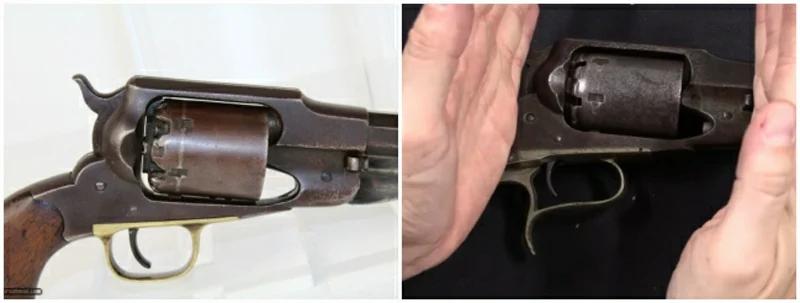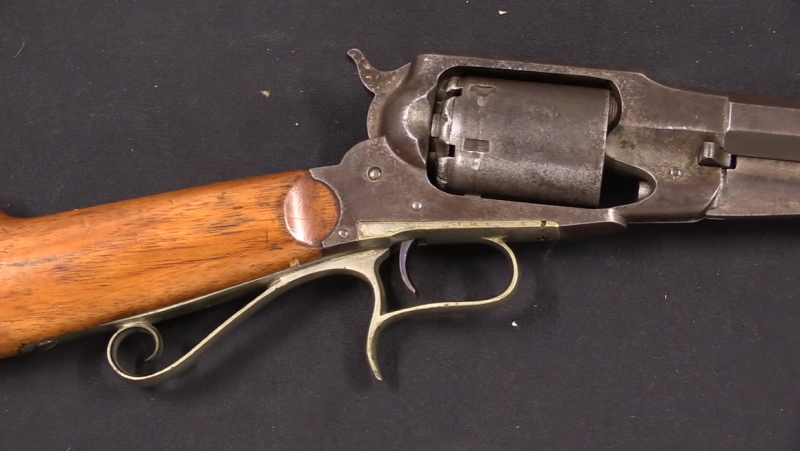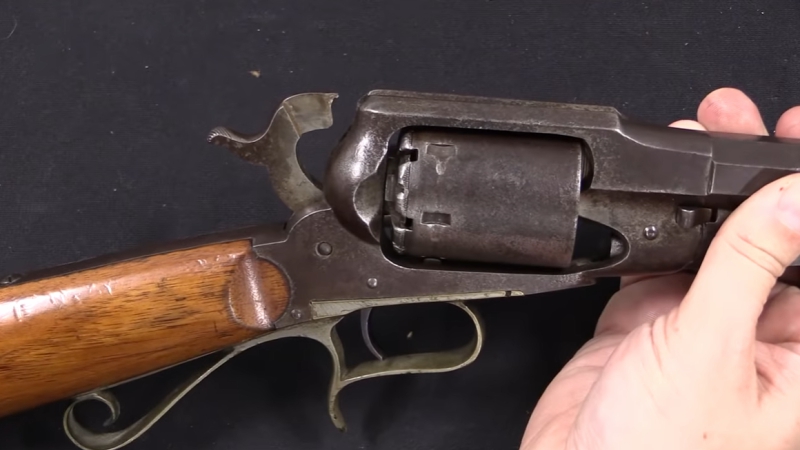You can always count on Ian McCollum of Forgotten Weapons to show you something cool. The Remington Revolving Rifle is no exception. When the Civil War ended in 1865, Remington was left with a bunch of stuff laying around as demand fell off a cliff. Developed as a means to sell some of that stuff, the Revolving Rifle was marketed as a hunting rifle, now that young men had time to hunt again.

Basically, Remington took the frame of the New Model Army Revolver, which had been around since 1858, and married it to a long octagonal barrel and the stock from their new single-shot Beals Rifle. It was actually not a bad idea. They were able to repurpose some existing inventory and tooling and produce a new firearm with very little upfront investment.

Introduced in 1865, the rifle was a percussion gun available in .36 and .44 caliber. The smaller framed .36 was the more popular of the two by a margin of about two to one. There were lots of variations, as the factory was willing to customize and tool the rifles if you were willing to pay extra.

Remington quickly saw that cartridge, not percussion, guns were the way of the future and, beginning in 1872, offered the guns as “cartridge conversions.” That date is significant because the previous year had seen the expiration of Smith & Wesson’s patent on bored-through cylinders, making it less expensive to build and market guns with that technology. The new cartridge guns converted the chamberings from .36 to .38 long rimfire and .44 to .46 long rimfire.

In all, about half the guns were cartridge conversion models while the rest remained percussion guns. Remington offered factory conversions for guns already purchased and some independent gunsmiths also did the work, meaning that some rifles have different styles of rimfire conversion. After the conversion, the .38 version kept its six-shot capacity while the .46 was reduced to five due to space limitations in the cylinder.

The gun Ian shows us is a .38 long rimfire conversion. The original gun would have had a six-shot cylinder with percussion cap nipples and a hammer designed to fire those caps. The conversion has a reconfigured hammer to fire rimfire cartridges and a new two-part cylinder. The loading rod, originally designed to ram home projectiles in the percussion system, was now only necessary to release the cylinder access pin. Removing the pin allows the cylinder to be removed, which is necessary for loading and unloading. The loading rod is similar to the New Model revolver but has been extended on the rifle for easier use. That obviously wasn’t possible on the shorter revolver.

The cylinder is bored for six rounds, which are inserted after removing the backplate. The backplate provides the ratchet mechanisms to rotate the cylinder. It also has ports cut to expose the rim of the cartridge for the hammer to strike. The gun is single action with nice positive clicks as the hammer is drawn back to cock or half cock positions.

The buttstock is a traditional pointed version. I always think of them as horns, but maybe that’s just me. The stock could be as plain or as fancy as you wanted, depending on your budget. The front sight is a blade, and the rear sights are attached to the barrel forward of the frame. There were different kinds of rear sights. Ian’s example is a buckhorn style. There was a deep groove cut in the top strap of the frame allowing a clear sight picture.

Most barrels were octagonal but round barrels were available, again, if you want to pay for it. Standard barrel lengths were 24, 26, and 28 inches. Ian’s example is 26 inches. Custom barrel lengths were available and at least one 22-inch and one 30-inch barreled gun are known to exist. At the time, hunting rifles were highly customizable, say it with me, for a price.

Overall, the Remington Revolving Rifle was a commercial failure. Over a thirteen-year production life, only 800 guns were sold. Their original asking price was $31 to $33, depending on the barrel length. Their final listing in the Remington catalog was in 1879, when they were going for $25, regardless of barrel length. Remington just wanted to get rid of them at that point.

Earlier, I said that the rifle was behind the times from the beginning. The cartridge conversion models were introduced in 1872. The next year, Winchester introduced the classic Model 1873 lever action rifle. Now, honestly, which one are you gonna choose? By the end of the 1870s, Winchesters were everywhere and could do a lot more than the revolving rifle and do it better.

But, either way, Remington got some business for not much investment, and we got a cool, but very rare, rifle to check out. That’s gotta be worth something. Watch Ian’s video for a good look at the Remington Revolving Rifle.


